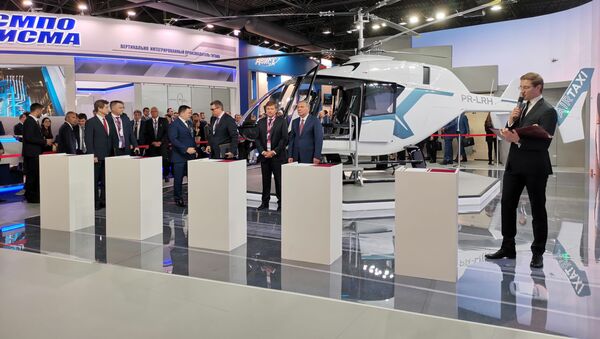The aerobatics show at the Ulan-Ude Aviation plant testing grounds looks like a scene out of a James Bond movie, but unlike Ian Fleming’s characters, these Russian ladies are not Auric Goldfinger’s bodyguards – they are members of the local aerobatics team rehearsing their routine for the plant’s 80th-anniversary celebrations.
When the ladies’ aerobatics team landed, it was the time for tests pilot to show off their Mi-8AMT flying skills. Produced at the Ulan-Ude Aviation plant, and exported as Mi-171, this particular model is very popular among foreign customers. pic.twitter.com/jAXNddw6oo
— Denis Bolotsky (@BolotskySputnik) 31 августа 2019 г.
The plant’s current lineup has several variations of the Mi-8AMT/Mi-171, including the “Arctic”, rescue and medical versions. Another model assembled in the Republic of Buryatia by “Russian Helicopters” - a holding company within the country’s tech giant Rostec, is the upgraded Kamov’s Ka-226T. The “domestic” Kamovs are frequently used by Russia’s emergency ministry and border service, and the export versions may very well find a new home in India if the authorities of the two countries reach an agreement on exports and manufacturing – a deal that has been in the pipeline for quite a while.
Last year the Ulan-Ude Aviation plant produced 76 helicopters, with about 20% being ordered by the Russian government, and 80% shipped to other clients, including foreign ones. Southeast Asia and South America are currently the manufacturer’s biggest export destinations.
The plant’s assembly lines have both foreign and Russian-made equipment. The helicopter parts manufacturing process requires high precision, but even parts made by robots have to be “double-checked” thoroughly to ensure quality.
While visiting the testing lab we were specifically told not to touch this horizontal surface because parts placed on it were being checked by a robot. An “arm” is slowly moving across the surface, comparing the part with its 3D layout pic.twitter.com/BQ4wBS171B
— Denis Bolotsky (@BolotskySputnik) 31 августа 2019 г.
Several years ago the Ulan-Ude plant was picked by four major Russian manufacturers as the place to make plexiglass products. It’s a part of a joint import replacement program that will allow airplane and helicopter makers such as the United Aircraft Corporation and “Russian Helicopter” factories, to use domestic glass parts instead of foreign ones.
Besides building and selling state-of-the-art flying machines, like Mi-171, the Ulan-Ude Aviation Plant also provides personnel training. It was a rare chance for journalists not only to see this equipment, but also to test their own pilot skills. pic.twitter.com/6ihofXSU77
— Denis Bolotsky (@BolotskySputnik) 31 августа 2019 г.
Like many other manufacturers around the world, the plant is now going “fully digital”. While even the updated Mi-171s were designed using up to 35% digital designs, Ulan-Ude’s new models, such as VRT500, which is now in development, will go “100 percent digital”.
Ulan-Ude’s Aviation plant's key future product is the VRT500. Its prototype is on display this week at the MAKS-2019 airspace show in the outskirts of Moscow. Once produced, the new model can be used in a number of ways, including urban passenger transfers. pic.twitter.com/EuNE56sNwL
— Denis Bolotsky (@BolotskySputnik) 31 августа 2019 г.
The single-engine VRT500 has a coaxial design and promises to become the “next big thing” among Russian civilian helicopters. Ulan-Ude Aviation Plant’s general director Leonid Belykh told journalists that his facility has received more than 8 billion rubles in funding over the past few years, and within the next 5 years - when the production of the VRT500 is expected to start, the funding will rise to 10 billion rubles. The new model will be built using a different approach to design, logistics and assembly.
“It’s a new project for us,” Belykh told journalists. “It will be certified using international guidelines. We already put a team together to work on this project, and we expect to start production in 2023. We did market research on how many such helicopters should be produced. It’s “the project of the century” for us, - a lucky chance, since new technologies of this kind have not been implemented here in the past,” he added.
A full-size prototype of the VRT500 is on display at this year’s MAKS-2019 airshow Zhukovsky near Moscow. “Russian Helicopters,” CEO Andrey Boginsky told journalists that the holding company is considering new joint projects, such as “Air Taxi” in collaboration with Yandex, and it is possible that the VRT500, once produced, will be put to use in similar ways.
"Russian Helicopters" CEO Andrey Boginsky at the MAKS-2019 talking about VRT500 and the future of air taxi concept. pic.twitter.com/i116WVBart
— Denis Bolotsky (@BolotskySputnik) 31 августа 2019 г.
“Russian Helicopters” - part of the “Rostec” State Corporation - is the country’s sole designer and manufacturer of helicopters. The Ulan-Ude Aviation plant is one of the holding company’s five assembly facilities. The company is taking part in the international MAKS-2019 airspace show, which will be open at Zhukovsky airport until 1 September.




